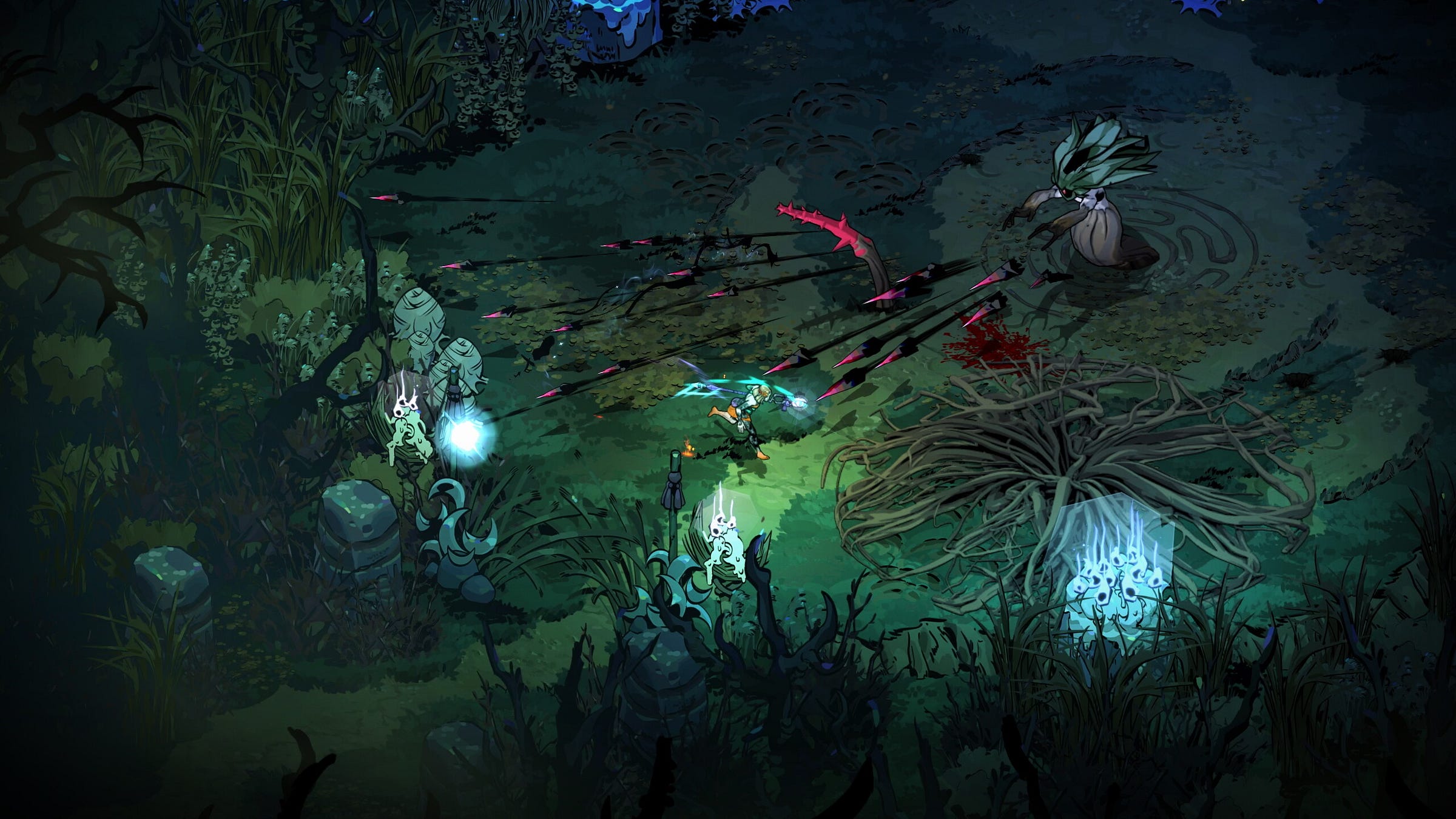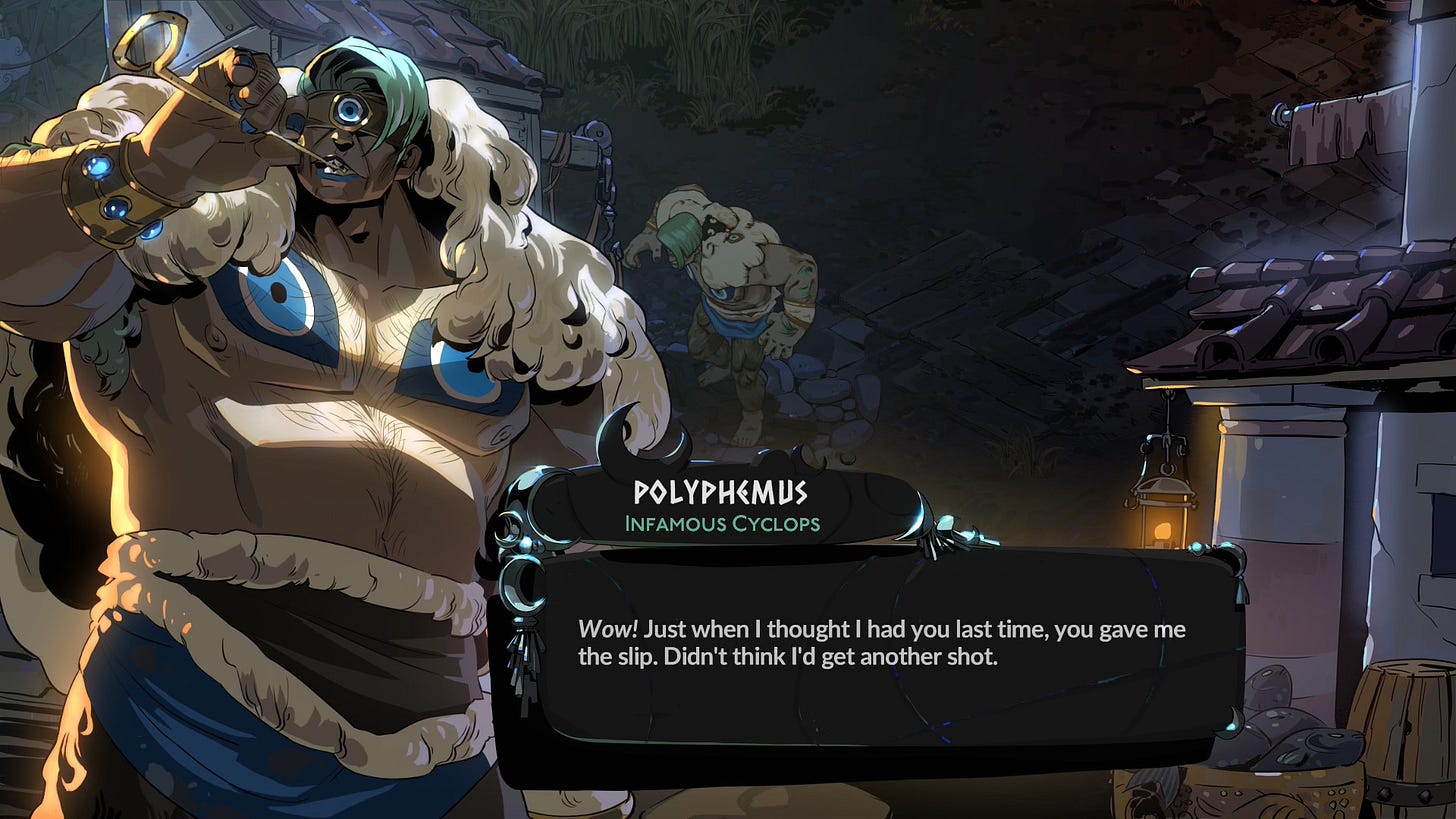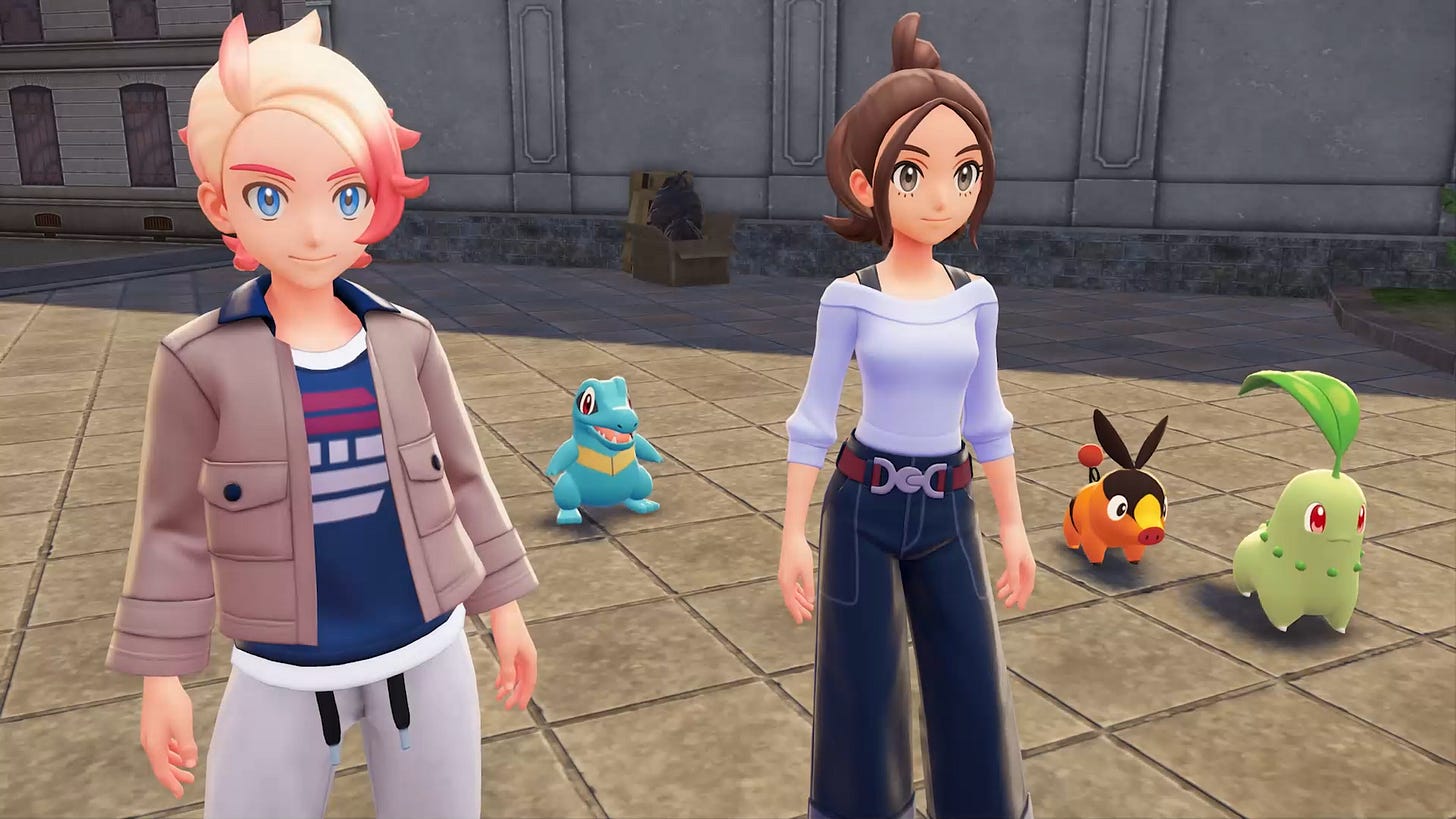"He looks different"
Hades II impressions, Pokémon's night-time royale and a Microsoft-Israel update.
Just for you, I have a second video game tip, barely a week after Game File’s first. Perhaps this might be a new thing at Game File, an SEO-driven tips-and-tricks strategy to draws in legions of new readers with the most Google-ready advice.
The tip:
If you are going to play Hades II—the celebrated new PC/Switch rogue-lite game of fighting, dying, upgrading and repeating that all over again—it is helpful to play alongside your 8 ½ year old kid who has gotten really into Greek mythology
This may be a harder tip to execute than adjusting the brightness settings or installing better drivers. It will have required some forethought and planning. But, for me, it’s been worth it.
About a year ago, my son discovered Greek mythology via a National Geographic podcast called Greeking Out. He then started selecting graphic novels about Greek mythology from the bookstore. Of late, our bedtime reading has involved trading off pages of Percy Jackson novels (he and I are nearly done with book 2; his curious sister has caught on, so she and I are mid-way through book 1).
Hades II is a game I’ve anticipated for some time, having enjoyed developer Supergiant’s past work (Transistor’s my favorite).
I assumed I’d enjoy it as another catchy, repeatable romp through the mythological underworld. The first Hades hooked me less with its setting—you played as Zagreus, son of Hades, battling his way toward dad—than with its crunchy combat and compulsive loops. Most of my runs into that game’s underworld terminated in failure, but not before I obtained some experience and some loot that could make the next plunge slightly more successful.
A week ago, however, I realized that Hades II’s combat and game design wouldn’t be the main draw for me. Nor would the protagonist shift to Melinoë, daughter of Hades, as she quested and killed her way toward the Hades-usurping Titan Chronos.
No, the allure of Hades II, I concluded, would be that I could sit my kids down next to it and show them versions of what they’d been reading about.
Over the weekend, I called the kids over to the TV to show them Hades II. My daughter didn’t care much, but my son was transfixed: There was Zeus! And Poseidon! Odysseus, too. And, look, we’re about to fight Scylla!
I’m about 30 runs into the game now. My son and I are also about 50 pages from the end of that second Percy Jackson novel, in which Percy has just battled the cyclops Polyphemus.
Yesterday, as we drove back from an errand, I told him I’d reached a new boss enemy in the game: Polyphemus!
My son wanted to see what he looks like in the game. At a stoplight, I took out my phone and loaded the Nintendo Switch mobile app (to which the Switch 2 auto-uploads captured screenshots; good job, Nintendo!). I enlarged a screenshot I’d snapped of Polyphemus and handed the phone to the excited boy in the back seat (his sister was at a play date).
“He looks different,” my son said, gazing at the game’s version of Polyphemus.
“Have you seen him before?” I asked.
My son paused. At the time, he wasn’t sure he had. Polyphemus “had looked more like a monster,” he said.
Maybe, I suggested, he was comparing what he’d envisioned of Polyphemus from reading Percy Jackson the night before. Later, I realized he had seen a version in George O’Connor’s graphic novel Poseidon: Earth Shaker.
My son wondered if Circe might also appear in the game, but if she also does, he floated, the people making Hades II might need to send the author of Percy Jackson some money. Today, over dinner, I told him about The Odyssey and how a lot of these stories come from that old tale.
I asked if he’d heard of The Odyssey. He wanted to know if it was real. The story is, but not what’s in it, I said.
He said he knew the word “odyssey.”
People use it to refer to big adventures, I noted.
“I know,” he replied. “Like Super Mario Odyssey.”
I played several more loops of Hades II last night. It’s largely very good. Combat feels great and is crunchier than ever. I spend a lot of my runs currying favor from the moon goddess, Selene, and upgrading a mid-run skill tree, to wield that power well.
The new Hades’ has its version of the original’s treacherous, semi-randomized room-by-room plunge into the underworld. But the sequel also has a more interesting, unlockable second half: an ascent toward Olympus that features less linear level progression.
The game’s biggest drawback is its economy, an overwhelming array of seeds, plants, ores, and trinkets that need to be collected and spent on a wide range of upgrades. Too often, I have the wrong currency and feel stymied as I dive into another run. The game could use some currency consolidation, perhaps a Hades equivalent of the Euro.
That issue aside, I’m enjoying Hades II’s best loop. Not the in-game ones, but the ones where I find a new mythological figure in the game, show them to the kids, then jump back in, trying to venture further to see who else I can find. I just found Circe. I’ll show them that one soon
Item 2: Pokémon Legends Z-I have no idea
I’m too old to have been bitten by the Pokémon bug when Pikachu and friends first became a thing. The pocket monster phenomenon started just after my gaming childhood ended. That might be why I’ve been able to transfer my love of Mario and Zelda games to my kids but not exactly turned out gaming time into Pokémon time.
The kids like Pokémon cards and have binders full of them. Those are unavoidable— except in school and summer camp where they are banned.
But the Pokémon video games we’ve sampled in the three years I’ve been playing new games with them have left them cold.
In 2022, we tried the Switch game Pokémon Scarlet (or was it Violet?). In 2023, we tried the second Detective Pikachu. Neither held their attention long.
Having no nostalgic warmth for the franchise—and having sampled a few hours of review copies of most of the big releases in the series from the past 15 years—is that Pokémon games are too clunky, their menu systems too cumbersome, their overall flow just too lacking in the polish associated with the best Nintendo-published games, for them to really care.
Or maybe that’s me being a snob?
Maybe the next Pokémon game will be the one for them?
The next one is Pokémon Legends: Z-A, out next month on Switch 1 and Switch 2. I tried a build of it in New York City earlier this month, in a loft rented by Nintendo. The new game, from longtime franchise studio Game Freak, is set in the Paris-inspired Lumiose City. The urban setting introduces the winning concept of an explorable metropolis cohabitated by people and Pokémon.
As with 2022’s Pokémon Legends Arceus, Z-A is meant to break tradition. For this one, combat is in real-time rather than the series’ traditional turn-based contests. You control a customizable human who runs through the city, their pack of Pokémon in tow. In the main parts of the city, things are relatively civil. In wild areas, the Pokémon are ready to pounce. Your character has one Pokémon at their side, several more available to summon. As you encounter other Pokémon, you can send yours to attack or summon others on the fly, as the battle plays out in front of you without pause.
Z-A’s real-time Pokémon battle system is novel for the series and just might be the basis for a recent, controversial new patent secured by Nintendo and The Pokémon Company. That patent is about battles involving switchable, summoned creatures. It’d track that the new patent is about Z-A. The patents Nintendo has used to sue Palworld maker Pocketpair were based on systems introduced in the prior Pokémon Legends game, Arceus. Notably, news of that patent broke the day I played Z-A at Nintendo’s loft.
The insights I can provide about this game are limited.
I’m a magikarp out of water at Pokémon preview events, so I couldn’t tell you much about whether the game feels like a sufficiently interesting deviation from Pokémon norms, nor if it executes the essentials well enough. I can at least happily report that the game’s user interface signals which of your summonable Pokémon will have an advantage or disadvantage against the enemy Pokémon you’re about to fight. I need the help, because I have not a clue whether flying-type beats electric-type or if psychic is good or bad against grass.
The “Z-A” in the new game’s title refers to its special night-time variation. When the sun sets, Pokémon Legends: Z-A shifts into a special contest mode, a Z-A Royale in which human trainers start at level Z and battle computer-controlled rivals throughout Lumiose City to rank up. It seemed like a decent idea, though I couldn’t tell if the game’s day-time portion has its own unique elements. A small thing that caught my eye during the night-time royale: You can take on up to three optional tasks and try to clear them as you go. Those chores reminded me of the optional mini-checklists you can work through in mobile games (hopefully no one’s patented it!).
I’ll try Z-A with the kids later this fall, once it is out. But I’m going in skeptically. I have a better feeling about Pokémon Pokopia, the recently announced Pokémon life-sim game. But we shall see. There’ll always be a newer one to try.
Item 3: Microsoft cancels some services it provided to the Israeli military
A surprise development in a story Game File has been tracking all year: Microsoft president Brad Smith told employees today that the company “has ceased and disabled a set of services to a unit within the Israel Ministry of Defense (IMOD).”
Smith’s note specifically pertained to a cloud tech deal between Microsoft and the Israeli military that The Guardian reported in August was being used for mass surveillance of Palestinians. As the paper reported last month:
“… the cloud-based storage platform has facilitated the preparation of deadly airstrikes and has shaped military operations in Gaza and the West Bank.”
Today, Smith said a company review of IMOD’s use of Microsoft’s technology is “ongoing” but that initial evidence supports The Guardian’s report. He added:
“We therefore have informed IMOD of Microsoft’s decision to cease and disable specified IMOD subscriptions and their services, including their use of specific cloud storage and AI services and technologies. We have reviewed this decision with IMOD and the steps we are taking to ensure compliance with our terms of service, focused on ensuring our services are not used for mass surveillance of civilians.”
Pressure has been mounting on Microsoft over its dealings with the Israeli military, due to the country’s war in the Gaza Strip, a campaign classified by a United Nations commission earlier this month as genocide. (Israel called the assessment: “distorted and false.”)
Microsoft employees, some rallying under the banner No Azure For Apartheid, have interrupted company speeches and recently occupied Smith’s office to protest the company’s ties to the Israeli military. Investor groups have called on Microsoft to detail its AI and cloud contracts with the Israeli government. Earlier this month, NorthStar, a “socially responsible” investment group, said it joined a coalition owning $7.3 billion in Microsoft stock to push for “accountability” regarding the company’s deals with the Israeli military.
This past spring, Microsoft’s gaming division was targeted for a consumer boycott, in protest of its work with the Israeli government. In August, some workers at Microsoft’s Arkane Studios called on their parent company to cut ties with the Israeli military. (Read Game File’s interview with one of the Arkane developers behind that request.)
The Guardian reported today that termination of services announced by Smith “is the first known case of a US technology company withdrawing services provided to the Israeli military since the beginning of its war on Gaza.”
Hossam Nasr, an organizer with No Azure for Apartheid, told Game File that the termination is “a significant and unprecedented win for the campaign and our organizing.” But he called on the company to do more:
“…we know that this is not enough. Microsoft has only disabled a small subset of services to only one unit in the Israeli military. The vast majority of Microsoft’s contract with the Israeli military remains intact. Microsoft continues to be the technological backbone for a military that is carrying out the world’s most documented genocide. “
Israel’s ongoing offensive in the Gaza Strip that has killed an estimated 60,000 Palestinians, according to Gaza’s Health Ministry. The Israeli Defense Forces’ assault followed the October 7, 2023 Hamas-led attack that killed nearly 1,200 Israelis, per media reports, and took more than 250 people hostage.
In his note to employees today, Microsoft president Brad Smith hailed The Guardian’s reporting: “Its reports were based in part on sources outside Microsoft that had information we could not access in light of our customer privacy commitments. This helped inform our review.”
Clarification - 11:04pm, Sept. 25: The headline of this item has been updated to specify that Microsoft cancelled services that were used as part of contracts it has with the Israeli military; the status of the actual contracts—be they modified or cancelled in any way—is unclear.
Item 4: In brief…
🎮 Sony’s 2026 big-game plans for PS5 officially include rogue-lite sci-fi shooter Saros, the next game from Returnal studio Housemarque, which is now dated for March 20…and a bloody Insomniac-developed adventure about Marvel super-hero Wolverine, slated for the fall, per the most recent Sony State of Play.
Also from that State of Play: the next big appearance by Capcom’s Mega Man will be in a Sega racing game. The next big game for PlayStation VR seems like it will be Microsoft’s Flight Simulator 2024. Strange times!
🎮 Microsoft’s 2026 big-game plans include a new Forza Horizon set in Japan; announced for Xbox and PC at launch, with PS5 to follow.
No mention of Switch 2 for Forza Horizon 6….adding to the mystery of the dearth of announced Microsoft games for Switch 2.
🎮 Sega is remaking 2009’s Yakuza 3, as it continues to update the earliest games in its long-running Yakuza/Like a Dragon series. The February 2026 game will be sold alongside a spin-off side-story called Dark Ties, Eurogamer reports.
👀 Two surprise Nintendo moves:
Doug Bowser, head of Nintendo of America since 2019, is exiting the company at the end of the year; taking his role of chief operating officer of NoA is 19-year Nintendo veteran Devon Pritchard. Satoru Shibata, former president of Nintendo of Europe and a current senior executive at Nintendo’s Kyoto HQ, will also assume the role of NoA CEO. That title was recently unfilled but had previously been among those held by past Nintendo CEOs, including the late Satoru Iwata.
Nintendo released a new mobile game, the “social deduction” game Fire Emblem Shadows, the company’s first new mobile game since 2021’s Niantic co-developed Pikmin Bloom.







I also recommend your son check out The Cronus Chronicles by Anne Ursu! I loved them when I was his age, and they’re refreshingly different from Percy Jackson while still hitting the same emotional appeal.
Great reporting, and congrats on the shout out, Stephen!